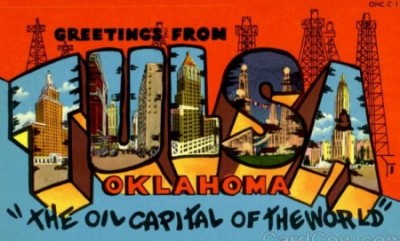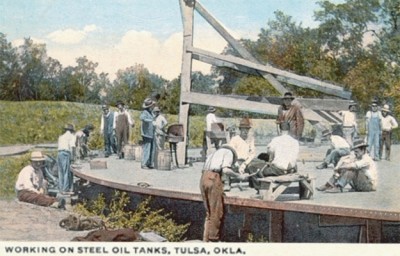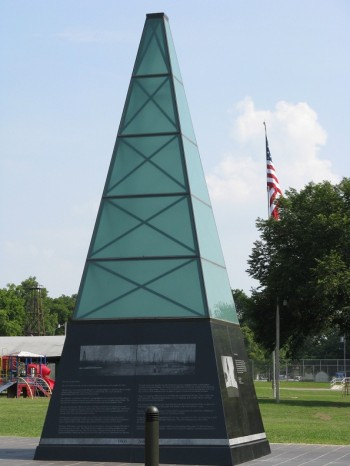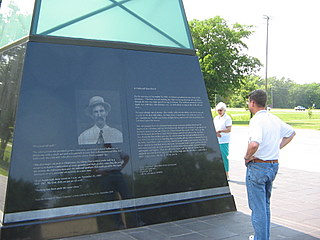Among the great Oklahoma oilfields, Glenn Pool in 1905 helped the careers of Sinclair, Getty and others.
Greater than the 1901 discoveries at nearby Red Fork and Spindletop Hill in Texas, the Oklahoma Territory Glenn Pool field produced a “light and sweet” oil from the Creek Indian Reservation. It would help make Tulsa the “Oil Capital of the World.”
On a chilly fall morning in 1905 — two years before Oklahoma became a state — oil was discovered on the Glenn family farm south of Tulsa. The oilfield discovery well launched a drilling boom that greatly exceeded the first Oklahoma oil well of 1897 at Bartlesville.

By 1920, Tulsa was home to 400 petroleum companies, two daily newspapers, seven banks, and 10,000 telephones.
The November 22, 1905, Glenn Pool oilfield discovery made headlines worldwide, attracting established exploration companies, new ventures, and a host of service companies. Soon, hundreds of Indian Territory wells produced so much oil the entire region was called the giant Glenn Pool, today Glenpool, a Tulsa suburb.
With daily production soon exceeding 120,000 barrels of oil, the Glenn Pool field exceeded Tulsa County’s headline-making Red Fork Gusher of June 1901 — and even the January 10, 1901, Spindletop Hill oilfield discovery at Beaumont, Texas.
The Ida Glenn No. 1
“Robert Galbreath and Frank Chesley had been alternating shifts on the floor of a cable-tool drilling rig in the Creek Indian Reservation,” explained geologist Norman Hyne in 2005.

“Black gold from this field helped fuel the nation and brought thousands of people and a new prosperity to Oklahoma,” explained the documentary, “The Glenn Pool Story.”
“They had paid for the lease and the rig — five dollars a day including driller — with their own money,” Hyne noted in an article for the American Association of Petroleum Geologists (AAPG).
“The well was on the banks of a creek located four miles south of an unimpressive, small town on the Frisco Railroad and the Arkansas River by the name of Tulsa,” added the professor of petroleum geology at the University of Tulsa.
The two men drilled deeper after first penetrating the Red Fork Sands formation with only a small show of natural gas. Then, at a depth of about 1,450 feet, Ida Glenn No. 1 well came in as a 75-barrel-a-day producer of high-quality oil — known as “light, sweet crude.”
The well was named for the Creek Indian woman from whom the oilmen had leased 160 acres at three-cents an acre plus a one-eighth interest in any production. Galbreath drilled a second well within 300 feet of his first well and then another. All were producers.
The wells revealed the 12-square-mile Glenn Pool, and a massive drilling boom began. Even with slow-drilling cable-tools, drilling was cheap because the productive sands were shallow, according to Tulsa author Ruth Sheldon Knowles in her 1959 book about wildcatters, The Greatest Gamblers.
By the time of Oklahoma statehood in 1907, Glenn Pool had made Oklahoma the nation’s biggest oil producer.

In 2008, the community of Glenpool dedicated a 28-foot-tall “derrick” to preserve petroleum history. Photo by Bruce Wells.
“It was Oklahoma’s first major oil field and the richest field the world had yet seen,” explained Hyne in his 2005 AAPG article (he also helped mark the field’s centennial by creating a Glenn Pool education center).
“Unlike the thick, sour oil from Spindletop, the famed 1901 Texas discovery that had already played out, this oil was light and sweet — just right to refine into gasoline and kerosene,” Hyne reported. “The reservoir was shallow, less than 1,500 feet deep, well within the range of the cable tool drilling rigs of that day.”
The geology professor added that within two years of the discovery, pipelines were built from the Texaco and Gulf refineries on the Gulf Coast and down from the Standard Oil refinery in Whiting, Indiana, to access the high-quality crude. Many other refineries soon appeared around the Glenn Pool.
Oklahoma Natural Gas Company in 1907 built a pipeline from the Glenn Pool to provide gas to Oklahoma City. The giant oilfield produced 325.5 million barrels of oil by 1986, and royalties of almost one million dollars a year were paid to Creek Indians who held 160-acre allotments in the field.
A number of prominent petroleum industry figures, including Harry Ford Sinclair, founder of the Sinclair Oil and Refining Company, and J. Paul Getty, received their initial start during the Glenn Pool boom, notes the Oklahoma Historical Society.
“It is said that more money was made on the Glenn Pool oilfield than the California gold rush and Colorado silver rush combined,” concluded Hyne. The historic Oklahoma oilfield would continue to produce using water-flood technologies (enhanced recovery) and producing primarily from small, marginal wells.

The monument, which illuminates at night, includes granite etchings telling the story of how Tulsa became the “Oil Capital of the World.” Photo by Bruce Wells.
In April 2008, a monument was unveiled in Glenpool’s Black Gold Park by the Glenn Pool Oil Field Commission. A 28-foot-tall “derrick” illuminates at night and includes granite etchings that tell the 1905 stories of oil explorers Robert Galbreath, Frank Chesley and Charles Colcord.
The commission also sponsored publication of Almost Forgotten — The Amazing Story of Glenn Pool: Oklahoma’s First World-Class Oil Field, distributed to high schools by the Oklahoma Energy Resources Board.
In addition, a documentary has educated many young people about the 1905 discovery. “Black gold from this field helped fuel the nation, and brought thousands of people and a new prosperity to Oklahoma.”
First broadcast in 2013 by the Oklahoma Educational Television Authority, “The Glenn Pool Story,” used rare archival photos and film clips, “to tell the compelling story of the Glenn Pool’s impact on America and how, a century later, the petroleum industry still benefits Oklahoma.”
_______________________
Recommended Reading: Glenn Pool…and a little oil town of yesteryear
(1978); The Greatest Gamblers: The Epic of American Oil Exploration
(1959). Your Amazon purchase benefits the American Oil & Gas Historical Society. As an Amazon Associate, AOGHS earns a commission from qualifying purchases.
_______________________
The American Oil & Gas Historical Society (AOGHS) preserves U.S. petroleum history. Please become an AOGHS annual supporter and help maintain this energy education website and expand historical research. For more information, contact bawells@aoghs.org. Copyright © 2024 Bruce A. Wells. All rights reserved.
Citation Information – Article Title: Making Tulsa “Oil Capital of the World.” Authors: B.A. Wells and K.L. Wells. Website Name: American Oil & Gas Historical Society. URL: https://aoghs.org/petroleum-pioneers/making-tulsa-oil-capital. Last Updated: November 11, 2024. Original Published Date: November 11, 2012.



